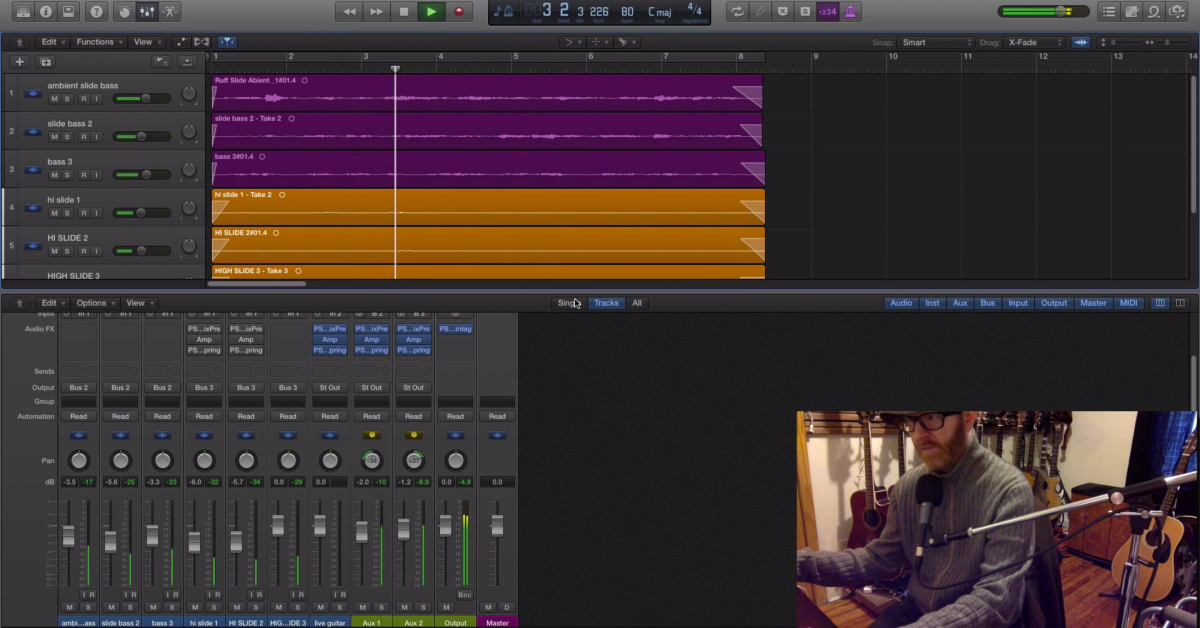The Fundamentals of Physical Modeling Synthesis
Article Content
Physical modeling is an approach to synthesis that is very different from other techniques such as FM or subtractive synthesis. This becomes obvious fairly quickly since the parameter choices are like nothing you would find in other types of synths. You may see controls for media loss, stiffness or tension, for instance.
The Metaphor
Often the metaphor of a vibrating string or wind instrument is used as the underlying premise and as a means of visualizing a hypothetical physical or mechanical scenario that would create an associated sound. These scenarios are not restricted to real-world practicalities, so it is possible to create otherworldly sounds – for example, a glass string, played with a bow, vibrating underwater.
Sculpture is the physical modeling virtual instrument that comes with Logic Pro and uses the vibrating string metaphor. From the Logic Instrument Manual:
Components such as the length of the neck, the material the instrument is made of — wood or metal, for example — the diameter, tension, and material of the strings — nylon or steel, for example — and the size of the instrument body can be modeled. In addition to the physical properties of the instrument, you can determine how and where it is played — softly bowed, or plucked, on top of a mountain, or under the sea. Other aspects such as finger noise and vibrato can also be emulated. You can even hit your virtual instrument strings with a stick, or emulate dropping a coin onto the bridge. Sculpture is not limited to recreating real-world instruments. You are free to combine components in any way, leading to bizarre hybrids such as a six-foot-long guitar with a bronze bell for a body — played with a felt hammer.
https://www.youtube.com/watch?v=BdnvSbSZBcU
Elements from Mutable Instruments is an incredibly powerful Eurorack module based on a physical modeling engine.
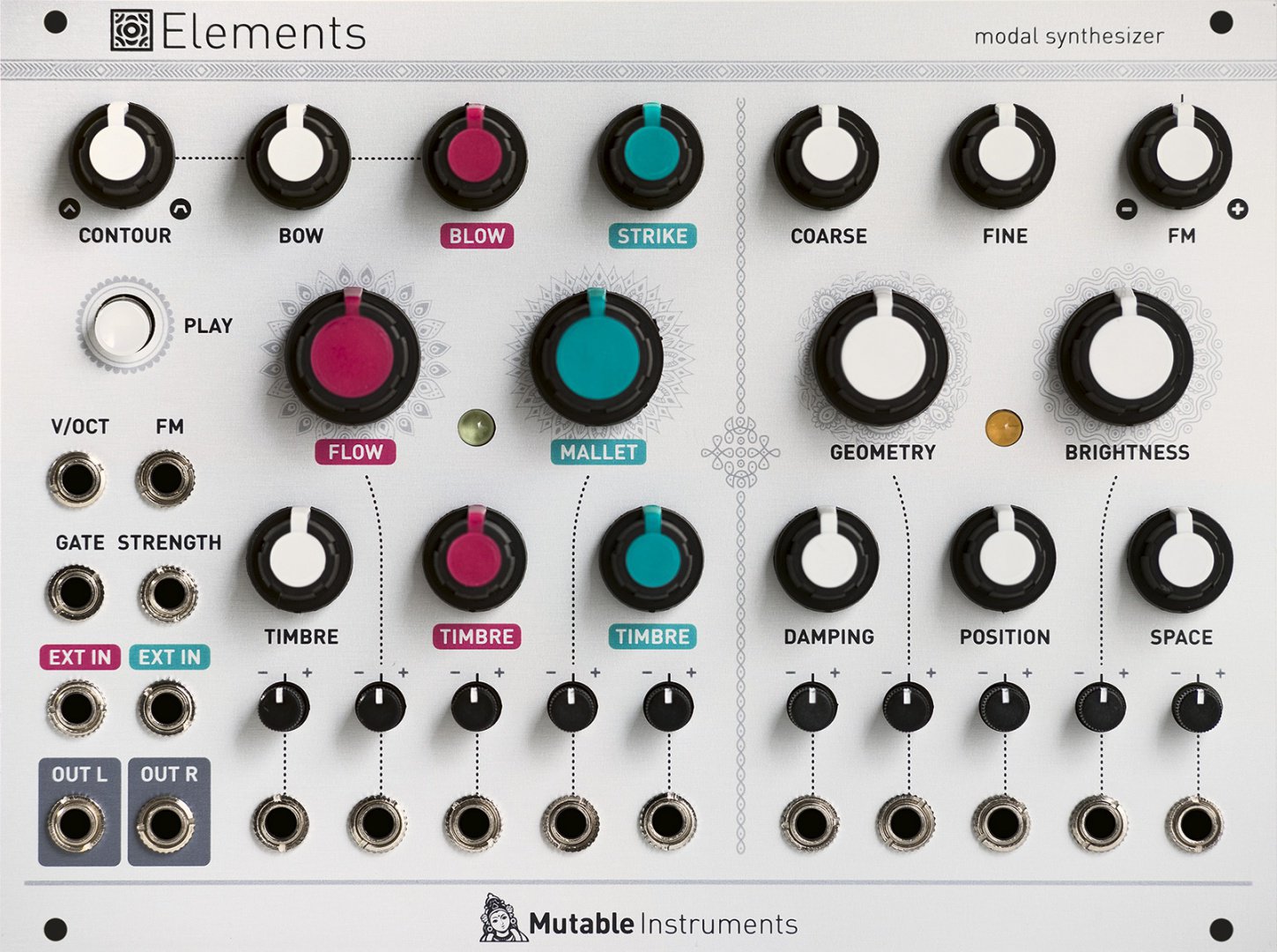
From the Elements user manual:
Elements is a full-blown synthesis voice based on modal synthesis — an under-appreciated flavour of physical modeling synthesis. With Elements, a sound is designed by specifying a resonant structure (plate, string, tube…), the properties of the material it is made of (stiffness, absorption…), and how the structure is excited to produce sound — struck, plucked, blown, bowed… (source)
The premise of modal synthesis (a form of physical modeling) revolves around resonance and the multiple resonant frequencies or modes that occur when energy activates an object and causes a system to vibrate.
“The shape of the instrument and the material it is made from determines the modes. Modes are characterized by their frequency, their amplitude, and their Q (quality) factor — how narrow the resonant frequency peak is.” (source)
Also pointed out in the Elements manual is the fact that the beloved Roland TR-808 drum machine uses modal synthesis. “The 808 produces sounds in imitation of acoustic percussion: the bass drum, snare, toms, conga, rimshot, claves, handclap, maraca, cowbell, cymbal, and hi-hat (open and closed). Rather than playing samples, the machine generates sounds using analog synthesis; the TR in TR-808 stands for “Transistor Rhythm”. (source)
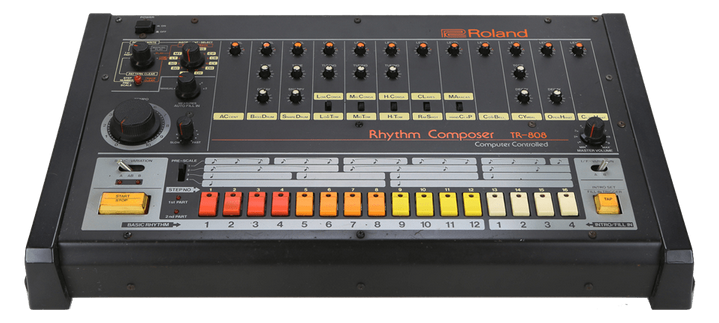
(image source)
The Method and Parameters
As opposed to the idea of having a source which is filtered or modified by an envelope as used in other methods of synthesis, physical modeling uses an algorithm to describe a sound producing mechanism as a whole. This allows for subtle variations that emulate an actual thing. (Russ 284)
When you change a single parameter, such as the method of excitation or the type of material, it may affect the sound in unexpected and substantial ways since parameters are tightly linked in modeling algorithms. This is particularly apparent in virtual instruments like Sculpture — where seemingly small adjustments can have huge sonic ramifications.
Russ breaks down Physical Modeling into two main categories:
- Continuous Models deal with blown or bowed instruments where there is a continuous transfer of energy into the instrument from the air flow or the bow
- Impulsive Models are for plucked or struck instruments, where a sudden ‘impulse’ of energy is transferred to the instrument … the sounds decays away naturally since energy is lost as friction, sound and movement once the initial input is taken away.” (Russ 286)
One simple example of an impulsive model is the Karplus-Strong plucked string algorithm. Also used for drum synthesis, Roads explains, “…[it] is an efficient technique based on the principle of a delay line or recirculating wavetable … the computational resources needed … are modest.” The algorithm uses a resonant frequency and attempts to simulate the decay of the sound after an initial excitation. Other more complex models may include things like the acceleration of the hammer as it hits a piano string or other subtleties that could occur in a real-world situation. (Russ 287)
Some instruments, such as Sculpture, incorporate both methods to some degree. Here is a list of excitation choices available in that instrument:
- Impulse – A short impulse excitation
- Strike – Short excitation, like a piano hammer or mallet
- GravStrike – Like hammer but with gravitation toward the string, leading to multiple hammer-string interactions and disturbed string vibrations
- Pick – Finger or plectrum picking
- Bow – Bowing of the string
- Bow Wide – Same as bow, but wider, resulting in a more mellow tone, especially suited for smooth bow position changes
- Noise – Noise injected into the string
- Blow – Blow into one end of the string (an air column, or tube)
- External – Feeds sidechain signal into a string
When choosing a specific excitation method other parameters appear that are particular to that method such as bow pressure or hammer start speed.
Sculpture allows the user to go further by choosing methods to disturb the already vibrating string:
- Disturb – A disturb object that is placed at a fixed distance from the string resting position
- Disturb two-sided – Somewhat like a ring placed around the string, which limits string vibration in all directions
- Bouncing – Emulates a loose object lying or bouncing on, and interacting with, the vibrating string — this is very random by nature and can’t be synchronized
- Bound – A boundary that limits and reflects string movement — this is much like a fingerboard that limits string movement when the string is plucked very firmly
- Mass – Used to model an additional mass attached to the string — this can lead to inharmonic sounds, and very interesting results if the position of this mass is modulated along the string
- Damp – Localized damper, which is useful for soft damping
The bouncing effect and gravity strike are iconic physical modeling sounds.
The user can also identify a location on the modeled string where the excitation takes place and the position of two virtual pick-ups.
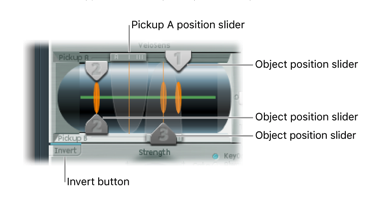
The Material pad offers a matrix that specifies what the metaphoric string is made of which influences its stiffness and inner loss (or dampening features), media loss which emulates an environment in which the string is vibrating, and tension which can create a momentary detuning.
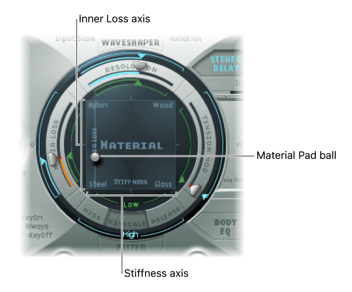
Aside from the excitation method and the nature of the material and vibrating environment, the resonant body is an important part of the physical modeling system. As Creasey explains:
A resonator is stimulated by the excitation and extends, amplifies and shapes the tome of the subsequent vibration, such as a drum head, piano string, xylophone bar, wooden violin body, or an air column in a clarinet. There might be multiple resonators in a single instrument that are coupled together, such as a string on an acoustic guitar, its wooden body, and the air inside the body. (Creasey 581)
In Sculpture, you can specify a “Body EQ” type which uses a modeled resonance profile such as an acoustic guitar, violin, banjo or ukulele to shape the sound. Other parameters that affect formant stretching and shifting can then be employed to modify the original profile into something completely different.
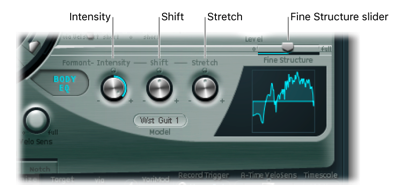
Collins summarizes the main avenues explored by researchers and developers involved with physical modeling:
- Analytical and numerical solutions – direct implementation by solving acoustical equations, through inspection, transform methods and other techniques
- Mass-spring models – an alternative way of breaking down complex acoustical systems into finite elements, using masses for discrete points and springs for the forces acting between masses
- Modal synthesis – study of exact modes of vibration of acoustic systems
- Waveguide synthesis – building physical models out of careful combinations of simple anti-generators like delays and filters, which model the propagation of sound waves and dispersion (Collins 175)
There is a substantial body of literature on the subject of physical modeling and I encourage the reader to explore the excellent sources mentioned here as a great starting point.
Conclusions
Physical modeling synthesis is a very different approach to creating sound that can yield unique results that go well beyond the idea of emulating acoustic systems. Virtual instruments like Sculpture are perfect for sound design applications thanks to an extensive degree of control and specificity. Mutable Instrument’s Eurorack synth voice, Elements, allows for the modulation of parameters via CV (control voltage), which can create unusual hybrid sonorities when connected to analog or digital oscillators and envelopes. While the parameters in physical modeling synthesis may seem at first foreign or even intimidating when compared to other methods, exploring these types of instruments is definitely worth your time.
______________________________________
References
Mutable Instruments | Elements, mutable-instruments.net/modules/elements/manual/.
Collins, Nick. Introduction to Computer Music. John Wiley, 2010.
Creasey, David. Audio Processes. Taylor & Francis Ltd, 2016.
Roads, Curtis, and John Strawn. The Computer Music Tutorial. MIT Press, 2003.
Roland TR-808 Wikipedia, Wikimedia Foundation, 14 Jan. 2019, en.wikipedia.org/wiki/Roland_TR-808.
Russ, Martin. Sound Synthesis and Sampling. Focal Press, 2013.
OV Valle [Roland US]. “TR-808 Drum Machine Flashback – Roland U.S. Blog.” Roland U.S., 26 Feb. 2015, www.rolandus.com/blog/2014/02/13/tr-808/.
Check out my other articles, reviews and interviews






